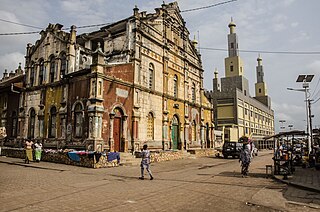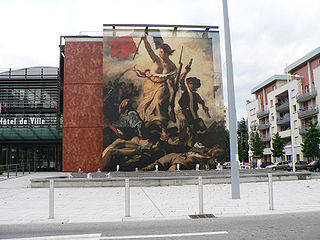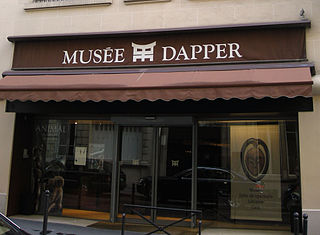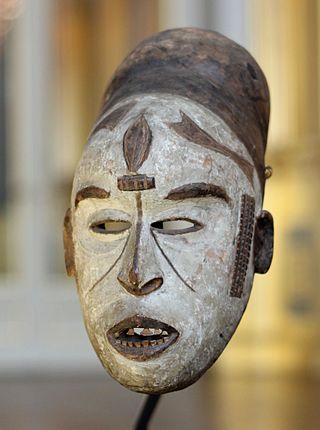Contents
This is a list of museums in Benin.
This is a list of museums in Benin.

The Musée d'Orsay is a museum in Paris, France, on the Left Bank of the Seine. It is housed in the former Gare d'Orsay, a Beaux-Arts railway station built between 1898 and 1900. The museum holds mainly French art dating from 1848 to 1914, including paintings, sculptures, furniture, and photography. It houses the largest collection of Impressionist and post-Impressionist masterpieces in the world, by painters including Berthe Morisot, Claude Monet, Édouard Manet, Degas, Renoir, Cézanne, Seurat, Sisley, Gauguin, and van Gogh. Many of these works were held at the Galerie nationale du Jeu de Paume prior to the museum's opening in 1986. It is one of the largest art museums in Europe.

Porto-Novo is the capital and second-largest city of Benin. The commune covers an area of 110 square kilometres (42 sq mi) and as of 2002 had a population of 223,552 people.

Benin has played an important role in the African music scene, producing one of the biggest stars to come out of the continent in Angélique Kidjo. Post-independence, the country was home to a vibrant and innovative music scene, where native folk music combined with Ghanaian highlife, French cabaret, American rock, funk and soul, and Congolese rumba. It also has a rich variety of ethnomusicological traditions.

L'Aigle is a commune in the Orne department in Normandy in northwestern France. Before 1961, the commune was known as Laigle. According to Orderic Vitalis, the nest of an eagle was discovered during the construction of the castle.

Échirolles is a commune in the Isère department, southeastern France. Part of the Grenoble urban unit (agglomeration), it is the second-largest suburb of the city of Grenoble, which is immediately to its north.

The Musée du Quai Branly – Jacques Chirac, located in Paris, France, is a museum designed by French architect Jean Nouvel to feature the indigenous art and cultures of Africa, Asia, Oceania, and the Americas. The museum collection comprises more than a million objects, of which 3,500 are on display at any given time, in both permanent and temporary thematic exhibits. A selection of objects from the museum is also displayed in the Pavillon des Sessions of the Louvre.

The Musée de l'Orangerie is an art gallery of Impressionist and Post-Impressionist paintings located in the west corner of the Tuileries Garden next to the Place de la Concorde in Paris. The museum is most famous as the permanent home of eight large Water Lilies murals by Claude Monet, and also contains works by Paul Cézanne, Henri Matisse, Amedeo Modigliani, Pablo Picasso, Pierre-Auguste Renoir, Henri Rousseau, Alfred Sisley, Chaïm Soutine, Maurice Utrillo, and others.
Frédéric Bruly Bouabré, also known as Cheik Nadro, was an Ivorian artist.

The Ouidah Museum of History is a history museum in Ouidah, Benin. It occupies the Portuguese Fort of São João Baptista de Ajudá (1721).

The National Museum of Gitega is the national museum of Burundi. It is located in Gitega and was founded under Belgian colonial rule in 1955. The museum is the largest of Burundi's public museums although its collection is displayed in a single room. In 2014 it averaged 20–50 visitors per week.

Musée Dapper was a French museum specializing in African art. It was opened in May 1986, and closed on 18 June 2017. The Dapper Foundation is still located at the same premises in the 16th arrondissement of Paris at 35 rue Paul Valéry, Paris, France.

Musée en Plein Air de Parakou is a museum located approximately 1.5 kilometres (0.93 mi) south of the centre of the city Parakou, Benin in the suburbs. The museum consists of five circular complexes representing the traditional housing of the local Batanou peoples. The museum as of 2006 was in difficulty given that it lacks the funds and maintenance to allow it to fulfill its potential as a showcase. The museum charges a CFA franc 1500 entrance fee.
Benin, officially the Republic of Benin, is a country in Western Africa. It borders Togo to the west, Nigeria to the east and Burkina Faso and Niger to the north; its short coastline to the south leads to the Bight of Benin. Its size is just over 110000 km2 with a population of almost 8500000. Its capital is the Yoruba founded city of Porto Novo, but the seat of government is the Fon city of Cotonou. About half the population live below the international poverty line of US$1.25 per day.

The Royal Palaces of Abomey are 12 palaces spread over an area of 40 hectares at the heart of the Abomey town in Benin, formerly the capital of the West African Kingdom of Dahomey. The Kingdom was founded in 1625 by the Fon people who developed it into a powerful military and commercial empire, which dominated trade with European slave traders on the Slave Coast until the late 19th century, to whom they sold their prisoners of war. At its peak the palaces could accommodate up to 8000 people. The King's palace included a two-story building known as the "cowrie house" or akuehue. Under the twelve kings who succeeded from 1625 to 1900, the kingdom established itself as one of the most powerful of the western coast of Africa.
The Royal Palace, also known as King Toffa's Palace and more recently Musée Honmé, is a former royal residence and today museum in Porto-Novo, Benin.

Some African objects had been collected by Europeans for centuries, and there had been industries producing some types, especially carvings in ivory, for European markets in some coastal regions. Between 1890 and 1918 the volume of objects greatly increased as Western colonial expansion in Africa led to the removal of many pieces of sub-Saharan African art that were subsequently brought to Europe and displayed. These objects entered the collections of natural history museums, art museums and private collections in Europe and the United States. About 90% of Africa's cultural heritage is believed to be located in Europe, according to French art historians.
Simonet Biokou is a contemporary Beninese scrap metal artist. He has also appeared in film, playing himself in the 1998 film Divine Carcasse, in which his character is shown creating a sculpture using car parts. His works have been featured in major metropolitan museums including the Metropolitan Museum in New York.

The Restitution of African Cultural Heritage. Toward a New Relational Ethics is a report written by Senegalese academic and writer Felwine Sarr and French art historian Bénédicte Savoy, first published online in November 2018 in a French original version and an authorised English translation.